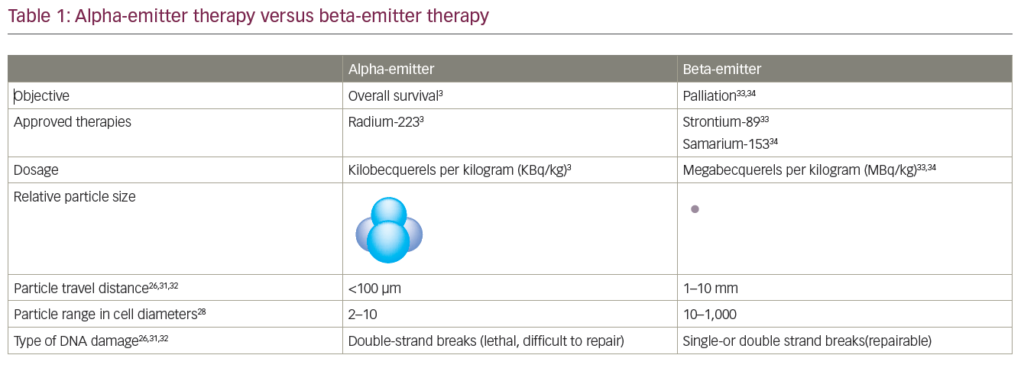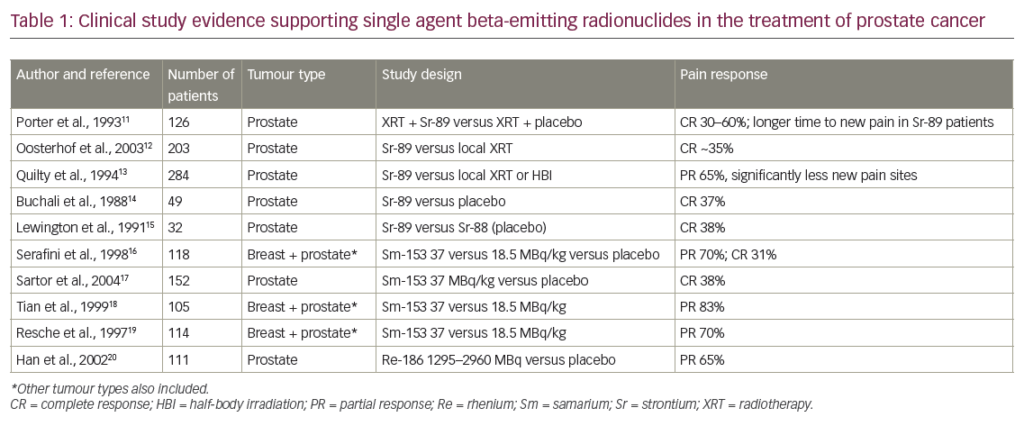Measurement of blood levels of prostate-specific antigen (PSA) and greater awareness have led to the detection of prostate cancer at an earlier and potentially more curable stage. As certain kinds of prostate cancer progress very slowly, some patients choose to undergo clinical observation (‘watchful waiting’) rather than active treatment. Alternatively, surgery and radiation therapy (RT) are the only curative treatment options. Hormone therapy (androgen deprivation) is another intervention used to enhance curative treatment or treat recurrent disease. RT can be administered in various ways, including external beam (EB), brachytherapy (the placement of a radiation source directly into a tumor), or a combination of both methods. Brachytherapy effectively targets the prostate and minimizes the dose to adjacent organs such as the bladder and rectum, because the dose decreases very rapidly as the distance from the radiation source increases.
There are two types of prostate brachytherapy: high-dose-rate (HDR) and permanent-seed. HDR brachytherapy is a precision technology for the placement of a brachytherapy source that employs robotic technology to temporarily deliver a high-intensity radiation source into the prostate and surrounding tissue. HDR is applicable to virtually all stages of localized prostate and many other types of cancer. It may be given as the only treatment (HDR monotherapy) for early disease or used in combination with external RT for locally advanced or higher-stage cancer. This article will describe HDR brachytherapy for prostate cancer.
High-dose-rate Brachytherapy
HDR describes more than the rate at which the radiation dose is given; it also offers a new dimension to brachytherapy. A single high-intensity radiation source located at the end of a wire is robotically inserted into thin brachytherapy catheters (close-ended straws) that have been temporarily inserted into the prostate. Instead of having a large number of uniformstrength permanent seeds, HDR applies a single radiation source that is time- and position-controlled during the treatment process. The longer the source stays in a particular location, the greater the effective radiation dose. Thus, HDR offers an infinite variety of source strengths at each of the hundreds of locations within the implant.
Along with the millimeter precision of source insertion, HDR provides the best opportunity to shape and control the distribution of the radiation. Delivery of treatment takes only about 20 minutes and occurs in a series of applications given over several hours or days. The radiobiology of prostate cancer favors large doses of radiation per session, thus HDR is well-suited for the control of prostate cancer. Due to the short duration of therapy, HDR has the benefit of a correspondingly short period of acute side effects.
The temporary HDR brachytherapy catheters act as stable scaffolding to permit precise and reproducible placement of the radiation source within and around the prostate gland. Consequently, there is a high degree of dose uniformity within the gland and excellent coverage of disease just beyond the edge of the prostate. Importantly, unlike with permanentseed brachytherapy, the dose of radiation is known before treatment and can be adjusted and individually tailored. There is no radiation exposure to medical personnel or families and seed migration to other organs cannot occur. Organ motion, of great concern in EBRT, is not a problem with HDR as the applicator is fixed to the target. Rectal doses are predictably low with HDR brachytherapy compared with EBRT.
The four steps of HDR brachytherapy are:1 image-guided applicator insertion,2 image acquisition of the completed implant (simulation radiography),3 dose distribution calculation (computerized dosimetry),4 and treatment delivery.1,2 The initial placement of thin, hollow, closed-ended catheters is performed under image guidance (ultrasound, computed tomography [CT], or magnetic resonance imaging [MRI]) and cystoscopy. The radiation oncologist and the urologist usually perform the outpatient consistent with other forms of RT. These results are among the best reported in the literature. We also reported results in 20054 on a total of 411 patients from the same period comparing patients who did or did not receive androgen deprivation therapy (hormone treatment). There was no difference in outcome identified in patients who received androgen deprivation therapy. The PSA and clinical control rates after 10 years of follow-up were 93% for the low-risk group, 87% for the intermediate-risk group, and 70% for the high-risk group. Local tumor control was 98% across all risk groups. These findings bring into question the need for androgen deprivation therapy when high doses of radiation are given to the prostate and surrounding tissue.
Based on the favorable experiences with both HDR and permanent-seed brachytherapy without EBRT in early-stage disease, we started HDR monotherapy for low- and intermediate-risk group patients (T1 or T2, PSA <15, and Gleason ≤7). We accomplished control of disease in 96% of cases (PSA progression-free survival) and observed a very low complication rate.5 To confirm that the EBRT was not needed, we performed a matched-pair analysis that compared the results of patients who received HDR and EBRT with the results of those who received HDR monotherapy.6 HDR monotherapy was as effective as the combined treatment program, so we concluded that for early cancer of the prostate HDR monotherapy is effective and ample treatment.
Published Literature
Table 2 shows the results from the literature of HDR in combination with EBRT in patients with low-risk disease. The mean PSA progression-free survival (survival with no clinical, radiological, or PSA signs of disease progression) was over 90%, with most patients having five or more years of follow-up.
Tables 3 and 4 show HDR brachytherapy and EBRT outcomes in patients with intermediate- and high-risk disease based on the length of follow-up. The definition of intermediate- and high-risk patients varies in the prostate literature. This is significant as upgrading patients to high-risk can exaggerate the efficacy of therapy. Regardless of this, landmark studies by Martinez et al.13 revealed that dosage dramatically affects tumor control. Patients who received the higher doses had an 87% control rate (PSA progression-free survival) compared with 52% in patients who received lower doses.
Table 5 shows the results of multi-institutional HDR studies performed to evaluate the benefits of treatment of androgen deprivation (hormone treatment) and radiation of pelvic lymph nodes. Neither a short course (<6 months) of androgen deprivation nor irradiation of pelvic lymph nodes was demonstrated to be of additional benefit.16–18 However, they confirmed the excellent results of HDR brachytherapy across all risk groups, including patients with Gleason grades 8–10.18
The results of HDR monotherapy (HDR given without EBRT) for low-risk and intermediate-risk groups are presented in Table 6.24–26 Our study of 298 patients from the CET and William Beaumont Hospital demonstrated a fiveyear control rate of 94% and a cause-specific survival rate of 100%, and there were no patients with distant metastasis. The rectal complication rates were <1% and there were <5% grade 3 urinary complications.
Advantages and Comparisons of High-dose-rate Brachytherapy
High-dose-rate Brachytherapy Is Intensity-modulated
HDR is ‘intensity-modulated’ (IM) because the longer the HDR radiation source resides in a particular location, the greater the intensity of radiation at that location. Modulating the intensity comes from adjusting the time the source stays at each position within the catheter matrix. It is the functional equivalent of having an infinite range of seed activity at every possible source position, so offers a new level of refinement in dose distribution control. IM HDR brachytherapy does not have the patient set-up and prostate motion problems associated with external-beam IMRT. HDR is delivered with great precision. The single high-intensity HDR source is robotically delivered into stable catheters with millimeter precision. The HDR source does not shift or migrate. Permanent seeds, in contrast, are manually inserted into deformable soft tissue and the final locations of the sources are usually, to some degree, different from those planned. Even if an ideal seed implant were accomplished, prostate swelling and seed migration after insertion may result in suboptimal dosimetry.
High-dose-rate Dosimetry Is Dynamic and Prospective
The distribution of the HDR implant catheters and dwell positions are known from 3D imaging and the dosimetry can be adjusted in advance of the source delivery. With permanent seeds, needle and source insertion are contemporaneous and the radiation sources are supposed to be static. The seed dose is determined retrospectively and cannot be modified. HDR brachytherapy differs from seed brachytherapy because the final HDR dosimetry is completed and approved by the physician before rather than during or after the administration of the source.
The Relationship of the Implant to the Patient’s Anatomy Is Known and Maintained During the High-dose-rate Source Delivery
An ideal radiation delivery system should establish and maintain the anatomical relationships to the target and the adjacent normal tissues throughout treatment. Permanent-seed and EBRT doses can differ substantially from the planned dose because of anatomical changes during the time it takes a permanent-seed implant to emit the dose or through patient motion or organ deformation during the course of EBRT. In contrast, the precise sequence of HDR simulation, dosimetry, and dose delivery, in conjunction with the short treatment duration, permits accurate pre-treatment dosimetry representations and reliable treatment delivery. Correct and reproducible geometric plan-to-target and sourceto- target relationships are achieved with HDR brachytherapy.
The High-dose-rate Sequence of Events Allows Multiple Opportunities to Optimize Therapy
Inevitably, in some cases brachytherapy needle or catheter placement will be suboptimal. The sequencing of HDR permits the physician to discover and improve suboptimal positioning and dosimetry either by moving the catheters to better positions or by utilizing computer software to optimize the dosimetry. In addition, relatively large prostates can be treated with HDR due to the flexibility of the catheter matrix system.
High-dose-rate Reliably Treats Cancer That Extends Beyond the Prostate
HDR brachytherapy’s ‘scaffolding matrix’ feature provides both general stability and the ability to place catheters at or beyond the prostate capsule and into the seminal vesicles without the possibility of source loss or migration to other organs. Figure 3 shows the 100% therapeutic isodose extending beyond the prostate capsule. Our high local tumor control rates in all risk groups confirm the efficacy of HDR brachytherapy to control disease both in and around the prostate.3–5
Control of Normal Tissue Doses Is Predictable with High-dose-rate Brachytherapy
The dose to the bladder and rectum is routinely kept within prescribed constraints (typically 75–80% at CET).4 It is a subtle but significant fact that at larger fraction sizes the biological differences are more pronounced than the simple percentages would imply. Thus, the biological doses to the bladder and rectum are actually lower than the nominal percentages. Dose limits are readily achieved by avoiding the urethra and rectum during catheter insertion and by making dwell time adjustments during the dosimetry calculations.
Radiobiological Advantages for High-dose Radiation in the Treatment of Prostate Cancer
It has been established that the repair of sub-lethal radiation damage for prostate cancer is comparatively lower than previously believed.22–27 It suggests that the large doses per session and the relatively short time course confer an important biological advantage to HDR brachytherapy.
Radiation Safety Is Excellent
Radiation exposure to people other than the patient does not occur with HDR brachytherapy. Complicated permanent-seed accounting measures are not relevant to HDR. There is no seed loss or environmental exposure.
High-dose-rate Causes a Comparatively Short Period of Acute Symptoms
All forms of RT cause transient acute inflammation of pelvic structures and temporary irritation of bowel or bladder function. The duration of these symptoms depends on the time taken to deliver the radiation, total dosage of radiation, and the volume of tissue irradiated. HDR brachytherapy limits the time, dose, and volume of radiation to normal structures so that the symptoms are of relatively short duration—two to three weeks—compared with those resulting from approximately two months of treatment during EBRT or after permanent-seed brachytherapy.
High-dose-rate Has Low Chronic Rectal and Urinary Complication Rates
Side effects of prostate irradiation are related to the total dose and the volume of the normal structures irradiated. By using the gradient effect of brachytherapy to limit the dose to surrounding structures, complication rates can be kept to a minimum. In the case of low- or intermediate-risk group cases, the use of HDR monotherapy (brachytherapy without EBRT) can minimize normal tissue injury. For example, rectal complication rates with combined HDR and EBRT at CET were 2% grade 1 and 2% grade 2,4 and for HDR monotherapy <1%.21 Similarly, chronic urinary side effects occur in <10% of cases and depend on underlying symptomatic benign disease and prior urinary surgeries.4 Conservative measures such as medication and avoidance of urinary surgery after RT are important for limiting long-term complications. The rates of urinary incontinence for patients who do not have surgical intervention are <1%.
High-dose-rate Is a Reusable Resource
HDR is appealing because the source both is reusable and can be applied to many patients and many different kinds of cancer other than prostate. The HDR source is potentially available, even in remote areas, without the logistics of source inventory or acquisition.
Follow-up Medical Care and Prostate-specific Antigen Testing After Therapy
Most patients are back to baseline status within one month of treatment. Subsequent PSA testing (every three months for two years and every six months thereafter) at the CET requires correct interpretation because transient risings (called PSA ‘spikes’ or ‘bounces’) may occur and should ot be misinterpreted as treatment failures.28 Biopsies within two years of treatment are frequently unreliable indicators of persistent disease.
Conclusions
HDR brachytherapy is a safe and effective treatment of localized prostate cancer. It combines the best characteristics of permanent-seed brachytherapy and the intensity modulation that typifies external-beam IMRT. It has great precision and is a dynamic process that permits excellent control of radiation dosimetry and treatment delivery. The relationship of the implant and dose distribution to patient anatomy are known in advance of treatment, so the dosimetry is prospective and hence modifiable. HDR reliably treats local extension of disease beyond the prostate. Normal tissue dose constraints are readily attainable, predictable, and reliable. There is a radiobiological advantage to the HDR fractionation and the accelerated treatment course. Radiation safety is optimal. Acute radiation side effects are of short duration and chronic effects are relatively few. HDR may be safely and effectively applied to all risk groups either as monotherapy for early to intermediate disease or in combination with EBRT for intermediate to high disease. It can also be safely and effectively applied to patients with larger glands, often without the need for hormone therapy. As with all sophisticated technologies, the accuracy of the technique depends on when and how it is used.















